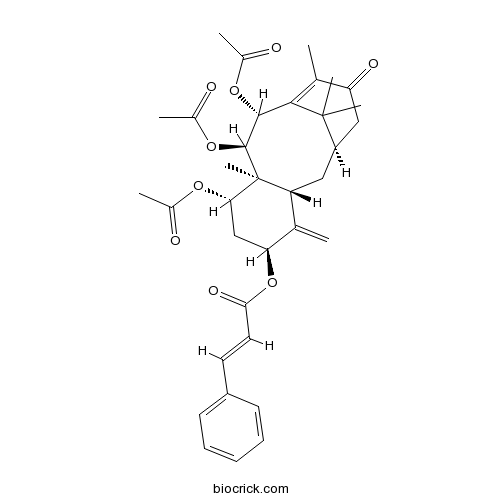2-Deacetoxytaxinine BCAS# 191547-12-3 |

Quality Control & MSDS
3D structure
Package In Stock
Number of papers citing our products

| Cas No. | 191547-12-3 | SDF | Download SDF |
| PubChem ID | 6442229 | Appearance | Powder |
| Formula | C35H42O9 | M.Wt | 606.7 |
| Type of Compound | Diterpenoids | Storage | Desiccate at -20°C |
| Solubility | Soluble in Chloroform,Dichloromethane,Ethyl Acetate,DMSO,Acetone,etc. | ||
| SMILES | CC1=C2C(C(C3(C(CC(C2(C)C)CC1=O)C(=C)C(CC3OC(=O)C)OC(=O)C=CC4=CC=CC=C4)C)OC(=O)C)OC(=O)C | ||
| Standard InChIKey | OBBKIKZFVSBXJQ-QJKHZRRKSA-N | ||
| General tips | For obtaining a higher solubility , please warm the tube at 37 ℃ and shake it in the ultrasonic bath for a while.Stock solution can be stored below -20℃ for several months. We recommend that you prepare and use the solution on the same day. However, if the test schedule requires, the stock solutions can be prepared in advance, and the stock solution must be sealed and stored below -20℃. In general, the stock solution can be kept for several months. Before use, we recommend that you leave the vial at room temperature for at least an hour before opening it. |
||
| About Packaging | 1. The packaging of the product may be reversed during transportation, cause the high purity compounds to adhere to the neck or cap of the vial.Take the vail out of its packaging and shake gently until the compounds fall to the bottom of the vial. 2. For liquid products, please centrifuge at 500xg to gather the liquid to the bottom of the vial. 3. Try to avoid loss or contamination during the experiment. |
||
| Shipping Condition | Packaging according to customer requirements(5mg, 10mg, 20mg and more). Ship via FedEx, DHL, UPS, EMS or other couriers with RT, or blue ice upon request. | ||
| Description | 1. 2-Deacetoxytaxinine B is a strongly inhibitor against U46619-induced aggregation. 2. 2-Deacetoxytaxinine B shows strong inhibitory effects against arachidonic acid (AA)-induced aggregation. |

2-Deacetoxytaxinine B Dilution Calculator

2-Deacetoxytaxinine B Molarity Calculator
| 1 mg | 5 mg | 10 mg | 20 mg | 25 mg | |
| 1 mM | 1.6483 mL | 8.2413 mL | 16.4826 mL | 32.9652 mL | 41.2065 mL |
| 5 mM | 0.3297 mL | 1.6483 mL | 3.2965 mL | 6.593 mL | 8.2413 mL |
| 10 mM | 0.1648 mL | 0.8241 mL | 1.6483 mL | 3.2965 mL | 4.1207 mL |
| 50 mM | 0.033 mL | 0.1648 mL | 0.3297 mL | 0.6593 mL | 0.8241 mL |
| 100 mM | 0.0165 mL | 0.0824 mL | 0.1648 mL | 0.3297 mL | 0.4121 mL |
| * Note: If you are in the process of experiment, it's necessary to make the dilution ratios of the samples. The dilution data above is only for reference. Normally, it's can get a better solubility within lower of Concentrations. | |||||

Calcutta University

University of Minnesota

University of Maryland School of Medicine

University of Illinois at Chicago

The Ohio State University

University of Zurich

Harvard University

Colorado State University

Auburn University

Yale University

Worcester Polytechnic Institute

Washington State University

Stanford University

University of Leipzig

Universidade da Beira Interior

The Institute of Cancer Research

Heidelberg University

University of Amsterdam

University of Auckland

TsingHua University

The University of Michigan

Miami University

DRURY University

Jilin University

Fudan University

Wuhan University

Sun Yat-sen University

Universite de Paris

Deemed University

Auckland University

The University of Tokyo

Korea University
- Epieriocalyxin A
Catalog No.:BCN1180
CAS No.:191545-24-1
- 2-Hydroxyxanthone
Catalog No.:BCN7545
CAS No.:1915-98-6
- Isoficusin A
Catalog No.:BCN6865
CAS No.:1914963-20-4
- LY 379268
Catalog No.:BCC7368
CAS No.:191471-52-0
- AGN 195183
Catalog No.:BCC5419
CAS No.:191469-29-1
- 3-Benzoylpropionic acid
Catalog No.:BCN1928
CAS No.:2051-95-8
- Fmoc-Tyr(HPO3Bzl)-OH
Catalog No.:BCC3565
CAS No.:191348-16-0
- Ursolic aldehyde
Catalog No.:BCN7712
CAS No.:19132-81-1
- 6-Deoxy-3-O-methyl-beta-allopyranosyl(1-4)-beta-cymaronic acid delta-lactone
Catalog No.:BCN1514
CAS No.:19131-13-6
- 1-Deoxynojirimycin
Catalog No.:BCN1032
CAS No.:19130-96-2
- Boc-Asp(OtBu)-OH.DCHA
Catalog No.:BCC3369
CAS No.:1913-12-8
- C 75
Catalog No.:BCC2386
CAS No.:191282-48-1
- Trimethylgallic acid methyl ester
Catalog No.:BCN3369
CAS No.:1916-07-0
- SIB 1553A hydrochloride
Catalog No.:BCC6284
CAS No.:191611-89-9
- Pomalidomide (CC-4047)
Catalog No.:BCC2246
CAS No.:19171-19-8
- Tenacissoside G
Catalog No.:BCN4682
CAS No.:191729-43-8
- Tenacissoside I
Catalog No.:BCN4681
CAS No.:191729-44-9
- Tenacissoside H
Catalog No.:BCN2570
CAS No.:191729-45-0
- Lenalidomide (CC-5013)
Catalog No.:BCC2245
CAS No.:191732-72-6
- Cyclo(Pro-Gly)
Catalog No.:BCN2417
CAS No.:19179-12-5
- Deoxypodophyllotoxin
Catalog No.:BCN1182
CAS No.:19186-35-7
- BIBO 3304 trifluoroacetate
Catalog No.:BCC7355
CAS No.:191868-14-1
- Flutax 1
Catalog No.:BCC7298
CAS No.:191930-58-2
- NTNCB hydrochloride
Catalog No.:BCC7270
CAS No.:191931-56-3
A comparative optical aggregometry study of antiplatelet activity of taxanes from Taxus cuspidata.[Pubmed:20170941]
Thromb Res. 2010 Jun;125(6):e281-4.
Platelets are highly reactive components of the circulatory system. The cytoskeleton of a platelet is an important structure for platelet aggregation as stimulated by several agonists. An anticancer agent, taxol, has been suggested to exert platelet anti-aggregating activity by stabilizing microtubules during the aggregation process. An activity-guided fractionation was performed with a methanol extract of the leaves and twigs of Taxus cuspidata to isolate taxanes with platelet anti-aggregating effects. Compounds 1 to 7 - taxinine (1), taxinine A (2), taxinine B (3), 2-Deacetoxytaxinine B (4), taxacin (5), taxchinin B (6), and taxol (7) - were obtained as the antiplatelet components of this plant. These taxane compounds present the possibility of securing new antiplatelet compounds which differ from currently available antiplatelet agents in chemical structure and possibly in mechanisms of action. All compounds showed stronger inhibitory effects than acetylsalicylic acid (ASA) on platelet aggregation induced by arachidonic acid (AA) (IC(50): 14.4, 64.5, 35.5, 16.0, 21.9, 28.6 and 48.2 versus 63.0microM) or U46619 (IC(50): 34.8, 24.9, 36.2, 35.0, 46.9, 71.9 and 68.7 versus 340microM). Compounds 1, 3, 4 and 5, with a cinnamoyl group at the C(5) position, showed strong inhibitory effects against AA-induced aggregation compared to compound 2 (with an -OH group at C(5)) or compounds with an oxetane ring at C(4),(5), such as compounds 6 and 7. All of the seven compounds were 5-13-fold more strongly inhibitory than ASA against U46619-induced aggregation.


